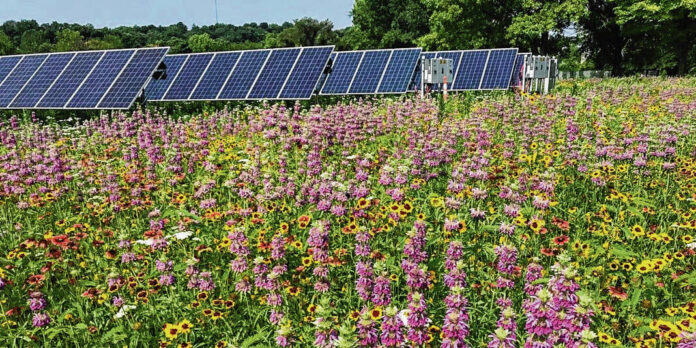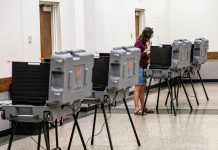
A pollinator-friendly solar installation at the University of Dayton is similar to what developers say is planned at the proposed Swallowtail Solar Farm in northeast Bartholomew County.
COLUMBUS, Ind. — A decision on regulations for proposed commercial solar fields will be delayed until August after more than 80 people crowded into a Columbus City Hall meeting room Wednesday to give their comments about the proposal.
The Bartholomew County Plan Commission gave up to five minutes per person to about 26 people to present evidence or express their concerns about proposed regulations for solar farms.
Much of the commentary centered around a proposed joint venture between Arevon Energy Inc. and Teneska, an Omaha, Nebraska energy company. The two companies want to create a potential 200-MW Commercial Solar Energy System (CSES) to be called “Swallowtail Solar Farm.”
Because of the large amount of information and commentary presented during the three and a half hour hearing, commission members agreed to wait before voting on the proposed regulations, or to consider possible revisions.
A final recommendation will go to the Bartholomew County commissioners, who have the final say about the amendments and the proposal. The county commissioners may adopt the recommendations as presented, make revisions or reject the proposals.
The commercial solar energy facility is proposed to be located somewhere between County Road 450N to the north – State Road 9 to the east – East 25th Street to the south and County Road 425E to the west, according to GPS coordinates. However, no exact location has been announced. A corporate news release states the project would not start construction before the second half of 2024, pending all applicable approvals.
A significant concern among audience members was the impact of a solar field on neighboring property values. Local real estate broker Jeff Hilycord cited a study published in 2020 by the University of Rhode Island that claims property values within one mile of a solar field decline by an average of 1.7%, and homes within one-tenth of a mile drop by 7%. But later in the program, another speaker said the Rhode Island study concerned only solar farms installed in urban areas, rather than rural.
Another concern brought up was farmer property rights, which has been a significant topic in many cases heard by the Bartholomew County Board of Zoning Appeals. The board would be asked to approve any variance that would allow a commercial solar field to be installed on land zoned for agricultural purposes.
There were two distinct camps present that appeared well-prepared and passionate about their positions Wednesday. One group doesn’t want any commercial solar placed on agricultural land, while the other supports the solar project.
But a number of solar power advocates were also critical of a proposed 500-foot setback from the solar panels to a neighboring property line if the neighbor’s property is five acres or less – or from the solar facility to the neighboring house if it is over five acres.
Claims were made those setbacks were more restrictive than those for a landfill, concentrated animal feeding operation, gravel pit or other undesirable land use. A quick fact check by city and county planner Jeff Bergman did not support those claims, but commission members said they wanted to research the claims in greater detail.
Members of green energy or environmental groups, as well as some landowners, told the commission that 500-foot setback would make it extremely difficult to create a commercial solar field. Vanderburgh and Montgomery counties have established 200 to 250-foot setbacks while Purdue University recommends only a 200-foot setback, they said. Bergman said a revision has been added to the proposed amendments that state the 500-foot setback requirement could be waived if the neighboring landowners agreed to such an arrangement.
The second most dominant topic during Wednesday’s hearings was about decommissioning a solar field after its 30-year lifetime ends.
According to the county’s proposal for regulations, a decommissioning appraisal on each local solar field would be held every five years. A number of property owners who have leased farmland say they have contracts with Arevon or Teneska that assure them they will never be financially responsible for getting rid of the installation.
But a few commission members asked what would happen if the solar panel company goes out of business or declares bankruptcy. Bergman said the ultimate responsible party for decommissioning a commercial solar facility would be with the landowner.
Henry Wischmeier, a member of the nonprofit “Bartholomew County Citizens Concerned about Commercial Solar Fields,” claimed a full-scale decommissioning could eventually cost up to $19 million, but gave few details to back up that claim.
Sen. Greg Walker, R-Columbus, asked a lot of questions about decommissioning. They include: “When the solar fields are decommissioned, are the panels to be recycled or buried in the county landfill?” and “Will these panels even be safe to dump in the landfill?” Another of Walker’s questions asked who would be qualified to challenge a decommissioning cost estimate.
In response, local Democrat Sharon Kreig brought up Walker’s 2017 support of a bill that phased out net metering, which allowed homeowners with rooftop solar panels to sell excess power to utility companies. According to a 2017 news account, Walker said the practice of net metering unfairly forced customers without solar panels to subsidize those who have them.
Some other regulations contained in the proposal are:All structures, equipment, storage areas and fencing, along with the solar panels, to be set back a minimum of 50 feet from the actual or planned right-of-way next to the nearest street or road.
For rear yard setbacks, the distance must be a minimum of 30 feet from all side and rear property lines.
No commercial solar facility shall be located closer than half-a-mile to any municipal boundary line.
No electrical substation for a solar farm will be located within 750 feet of residential properties, while the minimum distance for related components shall be within 500 feet.
During the public hearing, Bergman reminded the audience that solar farms are currently allowed in Bartholomew County if the applicant receives permission from the local Board of Zoning Appeals. The planning director also said the proposed ordinance is not about a specific location, nor use of a commercial solar field. He also emphasized that the ordinance will not impact incorporated communities including Columbus, Hope and Elizabethtown.




